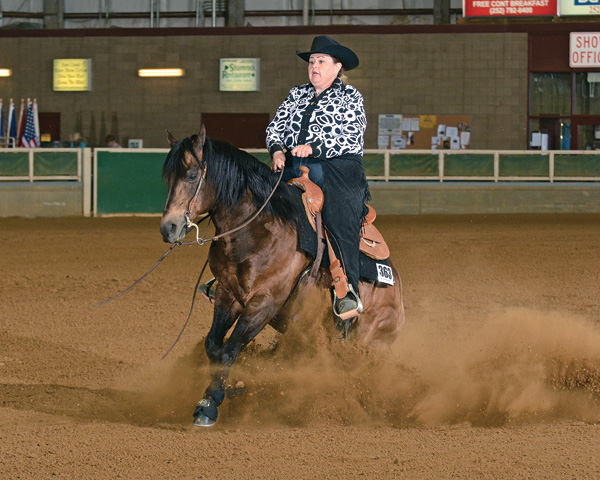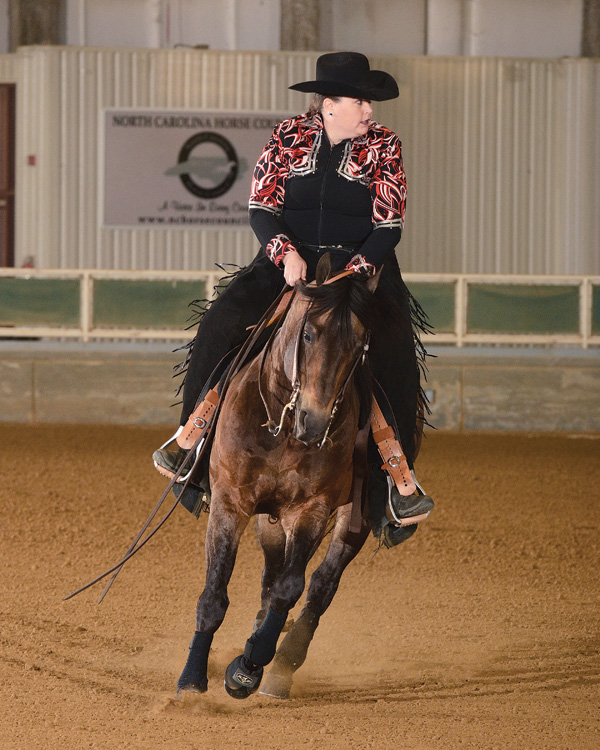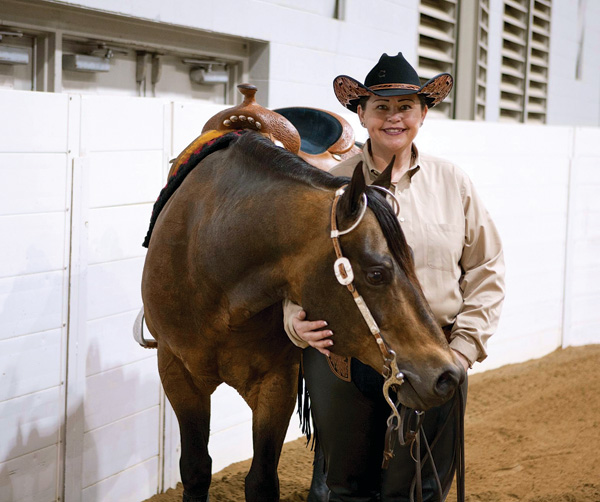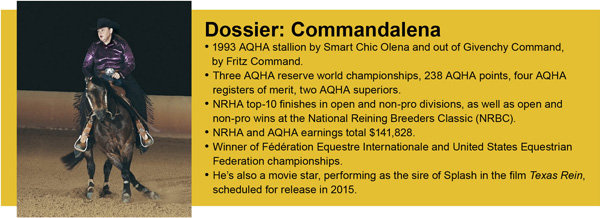What are the odds? Everyone wants to thumb through the online ads on a sunny afternoon and, as if by magic, find that “once in a lifetime horse”… with an affordable price tag. We all know that it’s about as likely as winning the lottery. But I’m here to tell you that it can happen—I know, because it happened to me, with a horse that truly is a dream come true.

I don’t have any special connections in the horse world. No magical insights. No crystal ball. When I bought Quarter Horse stallion Commandalena, I had just returned to the horse world at age 43 after an absence of more than 20 years. I did what most experts warn against: I bought a horse sight-unseen, didn’t get him vetted, and had him shipped across the country when he was 20 years old.
My roll of the dice paid off. In 2014, at age 21, Commandalena took me back to the show pen as a reiner and brought me win after win. He caught the attention of esteemed horsemen, and of mare owners as well. He also proved that a solid training foundation contributes to longevity. Here’s my story.
‘You Need a Hobby’
It all started when, almost two years ago, my husband, Brian Shoemaker, looked at me one evening and simply said: “You need a hobby.” I do need to stay busy. My work in the pharmaceutical industry, despite its challenges, left me needing more. The horse world beckoned.
I returned to my roots. In my early 20s, I’d ridden reiners at Memory Lane Farm in Westminster, Maryland. There, Charles Smith and Dutch Chapman were developing legendary programs to guide non-pro riders to the top. Bob LaPorta was one of their stars. Subsequently, he became the trainer/coach at Summer Wind Farm in Damascus, Maryland. I contacted Bob. He found a reasonably priced former broodmare that might work. Dun It Chexily had shown successfully in futurities and derbies, more than a decade earlier. We thought that I could bring her back, learn to show, and then move on to a more competitive horse.
My initial attempts at show-ring success were less than stellar. After several outings, all I had to show for my hard work were a few green-reiner points and less than $20 in earnings. Still, my mare’s pedigree suggested that if she wasn’t the show horse I wanted, she might be able to produce my dream horse. If showing a reining horse wouldn’t be a rewarding hobby right now, I reasoned, breeding one for myself might be my winning lottery ticket.
Long-Distance Jackpot
That was the thought process that led me to Commandalena. I saw him advertised online with a $20,000 price tag, later reduced to $10,000. I’d looked at a lot of online ads filled with beautiful photos of perfectly presented horses, but he stopped me in my tracks. This probably sounds silly, but I was struck by his eye—filled with so much kindness and intelligence. Later, I learned that he was famous for his athleticism, his mind, and his kindness.

But in September 2013, I only knew that he had significant National Reining Horse Association earnings and was 20 years old. I called his trainer, Tanya Jenkins, in Temecula, California. I told her that I had one mare. I wanted a stallion to ride and breed to my mare (and others I planned to buy). I wanted to produce some nice foals. She thought Commandalena would work for me.
What factors encouraged me to buy? Tanya has an excellent reputation. I felt she was honest. Commandalena had an amazing performance record. His past owner, Judy Clark, had taken great care of him, selling him only because of her serious health issue. His age didn’t bother me. Thanks to the experience with my mare, I knew that I could manage an older horse. I tried to add up the reasons not to buy him and couldn’t think of any.
I told Tanya that I wanted to fly out from Boston to see him.
“If you do, you’ll want to put him on the plane with you,” she replied. There was something so heartfelt in the way she said it that I knew I didn’t need to make the trip.
“Then put him on the next truck east.”
“You’re sure? We have one leaving tomorrow.”
A Winning Routine
Commandalena settled easily into his new life, first at Summer Wind Farm and then at Rising Star Farm, in Woodbine, Maryland, owned by non-pro competitors Don and Evelyn Burgy and operated by Dutch.

I quickly saw that Commandalena might make a great show horse for me: He was remarkably quiet, kind, and willing. But he needed conditioning, evident in his concave hindquarter muscles. I put my undergraduate degree in equine science to work.
I had his teeth done. An older horse’s teeth grow quickly and need frequent care. I devised a low-key routine to bring him into good physical condition while maintaining both soundness and willingness. For the next two months, he was longed daily at the walk and trot for about 20 minutes and then turned out in a grass paddock. I scheduled regular sessions with a masseuse.
Soon, I saw a spark in his eye and a lightness to his step. His muscling improved. He loved to work. The team at Chapman Reining Horses made sure he had good-quality forage and performance-horse grain mixed with senior feed (for its higher fat content) three times per day. They cleaned his water buckets daily; dirty water may result in decreased intake and colic risk. I made my own batches of daily supplements: an over-the-counter formulation for his joints and a probiotic for his digestive system. I researched available products, poring over labels and scientific journal articles to determine exactly what he needed. In the summer, I added electrolytes.
Finally, in December, I got in the saddle. Commandalena stood quietly. Then we walked and trotted. I knew that he would be a show horse for me.
In his program, we emphasized warm-ups and cool downs to prevent muscle injury, along with low-key bending exercises to strengthen his muscles and keep him supple. For instance, rather than ask him to spin, I’d bring my inside rein toward the back of my saddle and ask him to bend and cross over in front for one or two steps. We incorporated sidepassing to strengthen muscles he’d need for stops and rollbacks. You have to remember that there was no doubt this skilled athlete knew the maneuvers. He didn’t need to be schooled on them. He needed to build strength so that he wouldn’t be injured doing the job he knew so well.
After riding, I gave him full-body liniment baths to improve circulation and prevent muscle soreness. Proactively, I added standing bandages to prevent stocking up. As I said often, “I only have one horse to work with right now, so I have to take the best possible care of him.”
People began to comment that he looked like a 7-year-old. Finally, we re-introduced reining maneuvers. And I saw another piece of Commandalena’s special history. Conventional wisdom holds that he should’ve been full of bad “war horse” habits. He wasn’t. I credit Doug Milholland, of Purcell, Oklahoma, with having given him a wonderful foundation. Doug had trained him slowly and methodically, with a focus on longevity.
I was the lucky winner in all of this: To this day, Commandalena loves to go show and seems to shine when he’s part of a performance group. Even in the pasture, he looks at the arena and seems to want to go back to a social environment in which he has a job.
The Learning Curve
I, however, had some things to learn. Afraid to go fast, I pony-loped through my pattern, a problem that many green reiners share. Dutch helped me conquer my fear of speed and become a showman. On circles, he taught me to walk a few steps into the lead departure, lope off, and gradually lower my hand and move it up his neck as I clucked.

Commandalena amped up his speed a little with each movement/cluck. I realized that I could control how fast we were going. He was not going to run off with me. As I gained confidence, we went faster. Before the year was out, I turned in “plus one” circles. Talk about a personal accomplishment!
To help me deal with speed in the rundowns, we practiced rectangles. The mechanics of the exercise work like this: On the long side of the arena, you stay at least 15 feet from the side of the arena (mimicking the rundown) and gradually build speed, clucking and lowering your hand and bringing it up the horse’s neck an inch or so with each cluck.
Your hand and your voice tell him to pick up a little speed. Meanwhile, you keep your upper body back, as you would in the stop. When you get to the end of the long side, you ask for a 90-degree turn (what reiners call “squaring the corner”), collect his stride and go slow on the short side, square the corner again, and then repeat the speed-building exercise on the long side. This exercise allowed me to focus on what I had to do, while letting Commandalena do the job he knew. Gradually, we went faster, the dirt flew, and pony-loping faded into a distant memory.
I did have a few problems that stem from a horse that’s “been there, done that.” For instance, Commandalena is very good-leaded, but I quickly learned that if I didn’t keep my outside leg on through the center or if I happened to so much as glance away from my current circle, he’d assume that I meant for him to switch leads. If he switched and realized I wasn’t going on the new circle, he’d quickly switch back. I learned to keep my outside leg against his side and my attention focused on the next quadrant of my circle.
Highs and Lows
Soon, we were on fire in the show pen. The first high point? The Virginia Reining Horse Association Memorial Weekend Show, where we made a clean sweep of Green I and II and took home two high-point buckles. What made the experience even more special was how nice everyone was to me, an outsider who’d just come out of nowhere and won. A lot of these club members have become close friends.
I also had the opportunity to meet Doug Milholland. After he watched us show (and win), he told me how impressed he was with “one of his all-time favorite horses” and his continued success.
But reining is a humbling sport. The low point followed soon, when I lost—through a series of errors and miscommunications that had nothing to do with how my horse performed his pattern—the opportunity to represent Eastern Pennsylvania Reining Horse Association at the Rookie of the Year competition at the NRHA Futurity. The show advertising indicated that we’d be running one pattern, but there was a change, of which I was unaware until the last minute. On the way to center, I was learning the correct pattern. I turned to watch trainer Buck Haws draw the pattern in the air. In the process, I touched the back of my saddle. Even though we hadn’t technically started the pattern, the judges reviewed my ride and applied a 10-point penalty. My 143.5 score dropped to 133.5. We were out of the running.
But, in reining, things have a way of working out. Earlier in the year, I’d asked myself if we should go to the All American Quarter Horse Congress: Did my horse have enough, at age 21, to compete against the best in the country? He did. We were top-10 in rookie and limited non-pro and top-five in amateur reining, showing against very experienced horses and riders. I got another boost when internationally recognized trainer Casey Hinton, of Whitesboro, Texas, told me that he remembered Commandalena very well, adding “it’s great to see him looking so good.”
I’d wanted a year of fun, and Dutch and his team got it done for me. When I tallied the results, I’d had 38 wins, one of which included a score of 75, and earnings of $142,433! Dutch brought out the best in me—I became a showman—and Commandalena proved to the world, once again, that he is an astonishing athlete and an extremely kind horse. It was better than winning any lottery.
A Whole New Game
I may show Commandalena in 2015; he still loves his job. As I’ve always said, if he ever tells me he doesn’t want to be in the show pen, we won’t go there again. But the emphasis will be breeding. When I started showing him, I began to learn and process what other mare owners want. A lot of them seemed to want what Commandalena has. Thus, I now have numerous breeding commitments to Commandalena in the U.S. and Europe. There’ll be new games to play! I look forward to the future and the next roll of the dice!






